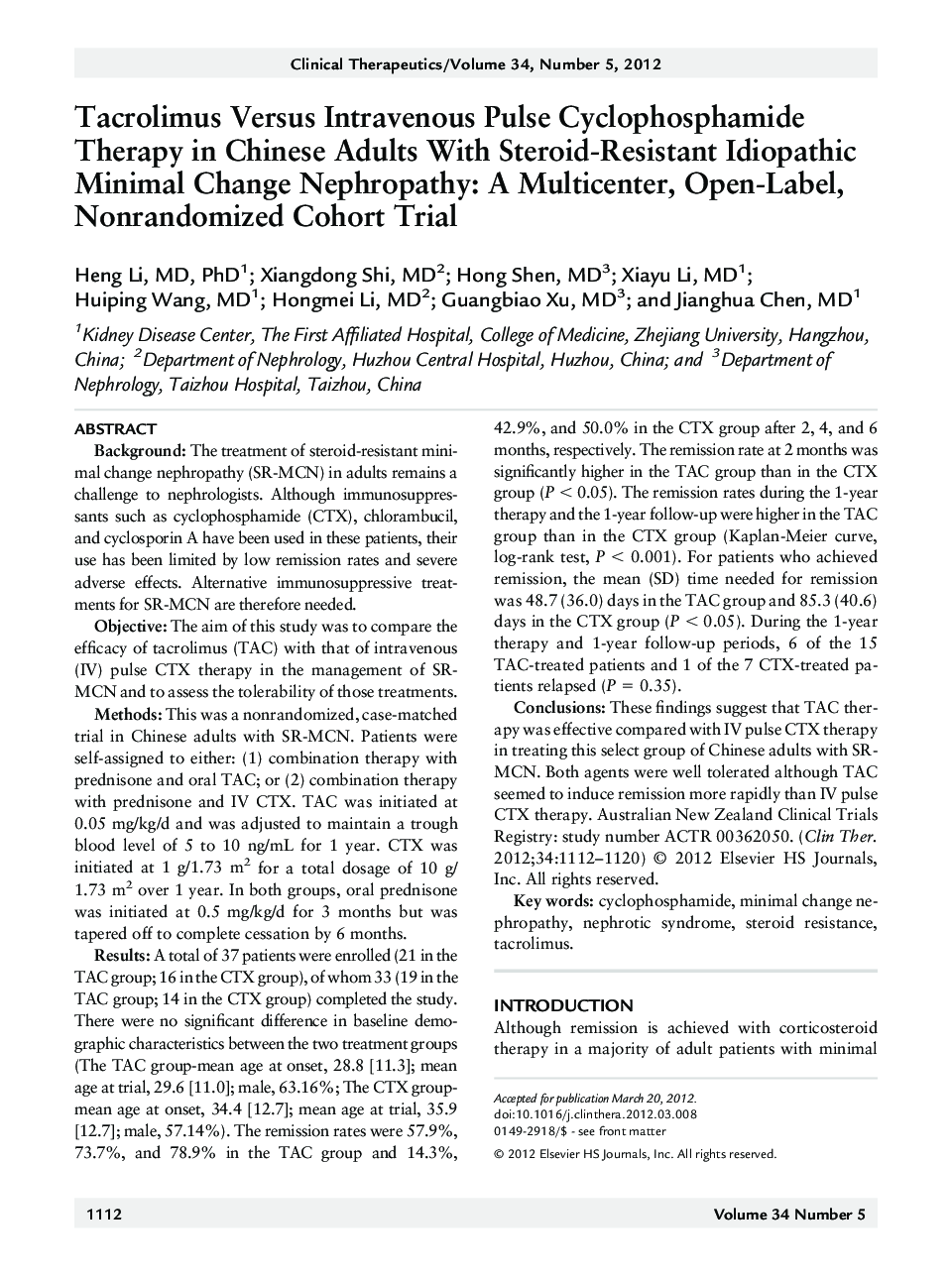| کد مقاله | کد نشریه | سال انتشار | مقاله انگلیسی | نسخه تمام متن |
|---|---|---|---|---|
| 2527884 | 1119945 | 2012 | 9 صفحه PDF | دانلود رایگان |

BackgroundThe treatment of steroid-resistant minimal change nephropathy (SR-MCN) in adults remains a challenge to nephrologists. Although immunosuppressants such as cyclophosphamide (CTX), chlorambucil, and cyclosporin A have been used in these patients, their use has been limited by low remission rates and severe adverse effects. Alternative immunosuppressive treatments for SR-MCN are therefore needed.ObjectiveThe aim of this study was to compare the efficacy of tacrolimus (TAC) with that of intravenous (IV) pulse CTX therapy in the management of SR-MCN and to assess the tolerability of those treatments.MethodsThis was a nonrandomized, case-matched trial in Chinese adults with SR-MCN. Patients were self-assigned to either: (1) combination therapy with prednisone and oral TAC; or (2) combination therapy with prednisone and IV CTX. TAC was initiated at 0.05 mg/kg/d and was adjusted to maintain a trough blood level of 5 to 10 ng/mL for 1 year. CTX was initiated at 1 g/1.73 m2 for a total dosage of 10 g/1.73 m2 over 1 year. In both groups, oral prednisone was initiated at 0.5 mg/kg/d for 3 months but was tapered off to complete cessation by 6 months.ResultsA total of 37 patients were enrolled (21 in the TAC group; 16 in the CTX group), of whom 33 (19 in the TAC group; 14 in the CTX group) completed the study. There were no significant difference in baseline demographic characteristics between the two treatment groups (The TAC group-mean age at onset, 28.8 [11.3]; mean age at trial, 29.6 [11.0]; male, 63.16%; The CTX group-mean age at onset, 34.4 [12.7]; mean age at trial, 35.9 [12.7]; male, 57.14%). The remission rates were 57.9%, 73.7%, and 78.9% in the TAC group and 14.3%, 42.9%, and 50.0% in the CTX group after 2, 4, and 6 months, respectively. The remission rate at 2 months was significantly higher in the TAC group than in the CTX group (P < 0.05). The remission rates during the 1-year therapy and the 1-year follow-up were higher in the TAC group than in the CTX group (Kaplan-Meier curve, log-rank test, P < 0.001). For patients who achieved remission, the mean (SD) time needed for remission was 48.7 (36.0) days in the TAC group and 85.3 (40.6) days in the CTX group (P < 0.05). During the 1-year therapy and 1-year follow-up periods, 6 of the 15 TAC-treated patients and 1 of the 7 CTX-treated patients relapsed (P = 0.35).ConclusionsThese findings suggest that TAC therapy was effective compared with IV pulse CTX therapy in treating this select group of Chinese adults with SR-MCN. Both agents were well tolerated although TAC seemed to induce remission more rapidly than IV pulse CTX therapy. Australian New Zealand Clinical Trials Registry: study number ACTR 00362050.
Journal: Clinical Therapeutics - Volume 34, Issue 5, May 2012, Pages 1112–1120